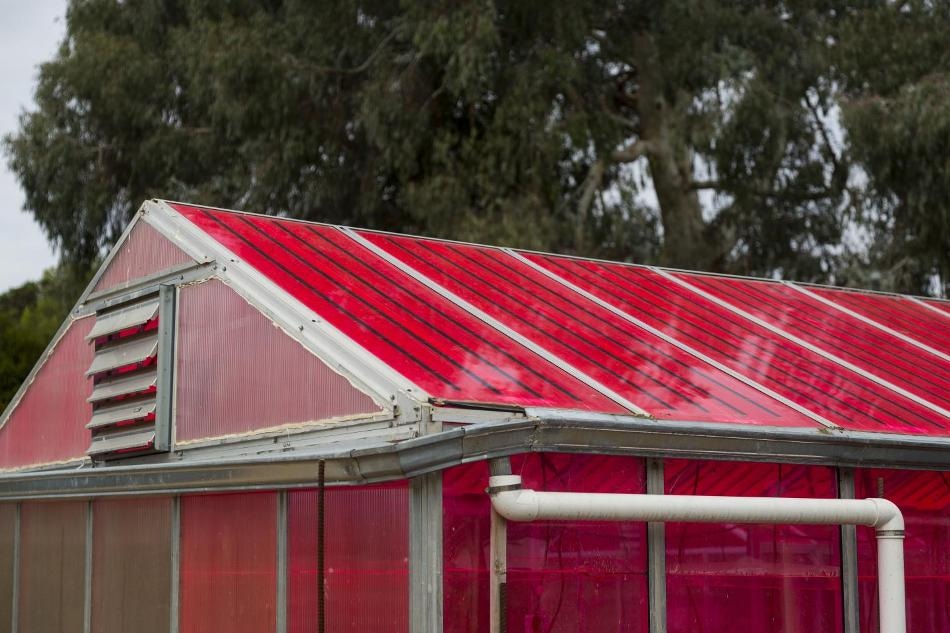Nov 6 2017

Plants grown in this "smart" greenhouse fared as well or better than plants grown in conventional greenhouses. (Photo by Nick Gonzales)
The first crops of cucumbers and tomatoes cultivated inside electricity-generating solar greenhouses were as healthy as those grown in conventional greenhouses, indicating that "smart" greenhouses hold significant potential for dual-use farming and renewable electricity production.
"We have demonstrated that 'smart greenhouses' can capture solar energy for electricity without reducing plant growth, which is pretty exciting," said Michael Loik, professor of environmental studies at the University of California, Santa Cruz, and lead author on a paper that has been published in the most recent issue of the American Geophysical Union's journal Earth's Future.
Electricity-generating solar greenhouses utilize Wavelength-Selective Photovoltaic Systems (WSPVs), a unique technology that produces electricity more efficiently and at less cost than standard photovoltaic systems. These greenhouses are furnished with transparent roof panels embedded with a bright magenta luminescent dye that absorbs light and conveys energy to narrow photovoltaic strips, where electricity is generated. WSPVs absorb some of the green and blue wavelengths of light but allow the rest through, allowing the plants to grow. WSPV technology was established by coauthors Sue Carter and Glenn Alers, both professors of physics at UC Santa Cruz, who set up Soliculture in 2012 to take the technology to market.
Loik's team observed photosynthesis and fruit production among 20 varieties of tomatoes, lemons, cucumbers, peppers, basil, limes, and strawberries raised in magenta glasshouses at two locations, on campus and one in Watsonville, California.
"Eighty percent of the plants weren’t affected, while 20 percent actually grew better under the magenta windows," said Loik. Cucumbers and tomatoes are among the top greenhouse-produced crops globally, he said.
In further experiments, small water savings were related with tomato photosynthesis inside the magenta glasshouses. "Plants required 5 percent less water to grow the same amount as in more conventional glasshouses," he said.
I thought the plants would grow more slowly, because it's darker under these pink panels. The color of the light makes it like being on the Red Planet, plants are sensitive not just to the intensity of light but also to color. But it turns out the plants grow just as well.
Michael Loik, professor of environmental studies at the University of California,
Decreasing the energy expended by greenhouses has become an urgency as the universal use of greenhouses for food production has grown six-fold over the past two decades to more than 9 million acres today—approximately twice the size of New Jersey, according to Loik. "It's big and getting bigger," he said. "Canada relies heavily on greenhouses for vegetable production, and their use is growing in China, too." Plastic greenhouses are becoming common for small-scale commercial farming, as well as for domestic food production, he added.
Greenhouses apply electricity to regulate temperature and power lights, fans, and other monitoring systems. "This technology has the potential to take greenhouses offline," said Loik, who specializes in climate change, plant physiology, water resources, and sustainable technologies. Cost per panel of WSPV technology is 65 cents per watt—about 40 percent less than the per-watt cost of traditional silicon-based photovoltaic cells.
If greenhouses generate electricity on site, that reduces the need for an outside source, which helps lower greenhouse gas emissions even more, we're moving toward self-sustaining greenhouses.
Michael Loik, professor of environmental studies at the University of California,
Additional coauthors include Catherine Wade, who contributed as a graduate student, Carley Corrado, who participated as a postdoctoral researcher, and undergraduates David Shugar and Devin Jokerst, all of UC Santa Cruz; and Carol Kitayama, senior grower at Kitayama Brothers Growers.
Plants fare well in 'smart' greenhouse
Electricity-generating solar greenhouses are outfitted with transparent roof panels embedded with magenta luminescent dye that absorbs light and transfers energy to narrow photovoltaic strips, where electricity is produced. A new study shows that this novel technology, which has the potential to take greenhouses offline, didn't interfere with plant growth or production.